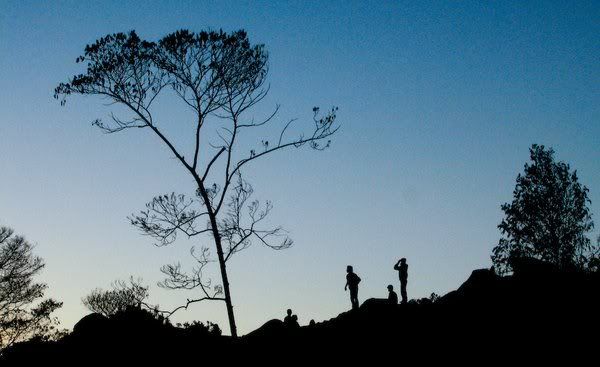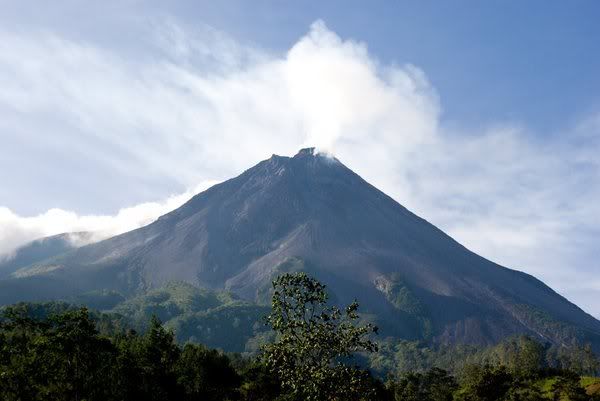Gaya Klasik Dance Yogyakarta
As a cultural city, Yogyakarta, can not be separated from the presence of dance that has existed since long. The existence of Gaya Klasik Dance Yogyakarta palace who grew up in the environment through a long time and high artistic value are the result of cultural work that can not be separated from Yogyakarta.
In general, the arts and cultural activities featuring classical dances still exist in the two palaces in Yogyakarta (Sultanate Palace and Puro Ngayogyakarta Pakualaman). Classical dances are: Bedhaya The Amurwabhumi. This dance is one of the Dance Classical Style that was created by the Sultan of Yogyakarta, Hamengku Buwana X. The work of this dance is the legitimacy of the Sri Sultan Hamengku Buwana X to swargi (late Sri Sultan Hamengku Buwana IX), which has a philosophical concept of loyalty to the promise, of a brave, sturdy, tolerant, always doing good and social. The concept and basic idea of this dance of Sri Sultan Hamengku Buwana X, while the choreography is KRTSasmintadipura. The Amurwabhumi Bedhaya first staged in Ward Kencono at the time of appointment and conferment of the title Hero of the lane IX in 1990. Bedhaya The Amurwabhumi danced by nine dancers and a duration of two setengahjam daughter, and accompanied by a dramatic rhythm that depict softness as a symbol of the most essential because every king always has its own expressions and concepts in each of devotion to its people by trying to garner good leadership through nurturing mindset and prosper the people. Bedhaya The Bedhaya Amurwabhumi as well as with other equipment in accordance with tradition and refers to a benchmark standard of dance bedhaya.Dasar story is taken from the fiber or the Book of The Queen Pararaton Tumapel and Majapahit. Bedhaya The Amurwabhumi take on the central story Amurwabhumi (Ken Arok) with Prajnaparamita (Ken Dedes) in menyimbolisasikan spirit of patriotism and leadership philosophy.
Classical dance is not merely gestures composition arranged into a single unit serving the whole spectacle, but it is stored behind a story or a high philosophical meaning to be conveyed as a message to human life.
Classical dance style of Yogyakarta-Mataraman this, you can enjoy in Nyayogyakarta Sultanate Palace and the Temple Pakualaman at every coronation ceremony or event that was held by the second palace. For those of you who want to see the process of training the dancers of this Classical Dance, can visit the Exhibition Hall located in the northern part of the palace every Sunday morning.
Meanwhile, for the location of the palace Pakualaman Classical Dance, you can enjoy at Temple Pakualaman located on Jl. Sultan Agung, Kecamatan Pakualaman, the city of Yogyakarta, Yogyakarta, Indonesia.
Location Yogyakarta Palace, located in downtown Yogyakarta to make access to the palace is very easy. In addition to using private vehicles, the palace is also accessible to the majority of public transport across the city of Yogyakarta.
Meanwhile, Temple Pakualaman Adisutjipto accessible from the Airport using the Trans-Jogja Bus (route 1A or 1B) pass through Jalan Sultan Agung Kusumanegara and by paying a fee of about Rp 3000.00. After about 25 minutes later, tourists can get off at Bus Stop in front of the Trans-Jogja Pakualaman Temple, then walk about 50 yards toward the temple Pakualaman. If departing from Terminal Giwangan, pewisata can use the city bus line 4 or line 12 pass through Jalan Sultan Agung, then down in front of Pura Pakualaman to pay around Rp. 3000.00 (2010).
In addition, if departing from Lempuyangan Station, travelers can use a pedicab or horse cart to the temple Pakualaman to pay around Rp. 15000.00 or can also use a taxi to pay the cost of approximately Rp. 20.000,00. While pewisata which departs from Monument Station may use a pedicab or horse cart headed to the Temple Pakualaman by paying the cost of approximately Rp. 10.000,00.
Tickets go into the front of the palace, namely Pagelaran and surrounding Rp. 5000.00 while admission to the inside of the palace through Keben Rp. 7000.00.
In the meantime, your visit to the Temple Pakualaman not charge a penny. The second palace in Yogyakarta is open daily at 08.00 till 17.00 pm. As for the Museum Pakualaman open on certain days, ie Monday, Tuesday, and Thursday, 09.00 to 13.30 WIB.
Parking for vehicles, there are around Pagelaran, about Keben, and the North Square. There are many souvenir kiosks around the palace. Inside the temple complex there is a Pakualaman Pakualaman Great Mosque which was built during the reign of Sri Paku Alam II. In addition, there are also Star FM Radio Station and the offices of the business units run by family Paku Alam.
In general, the arts and cultural activities featuring classical dances still exist in the two palaces in Yogyakarta (Sultanate Palace and Puro Ngayogyakarta Pakualaman). Classical dances are: Bedhaya The Amurwabhumi. This dance is one of the Dance Classical Style that was created by the Sultan of Yogyakarta, Hamengku Buwana X. The work of this dance is the legitimacy of the Sri Sultan Hamengku Buwana X to swargi (late Sri Sultan Hamengku Buwana IX), which has a philosophical concept of loyalty to the promise, of a brave, sturdy, tolerant, always doing good and social. The concept and basic idea of this dance of Sri Sultan Hamengku Buwana X, while the choreography is KRTSasmintadipura. The Amurwabhumi Bedhaya first staged in Ward Kencono at the time of appointment and conferment of the title Hero of the lane IX in 1990. Bedhaya The Amurwabhumi danced by nine dancers and a duration of two setengahjam daughter, and accompanied by a dramatic rhythm that depict softness as a symbol of the most essential because every king always has its own expressions and concepts in each of devotion to its people by trying to garner good leadership through nurturing mindset and prosper the people. Bedhaya The Bedhaya Amurwabhumi as well as with other equipment in accordance with tradition and refers to a benchmark standard of dance bedhaya.Dasar story is taken from the fiber or the Book of The Queen Pararaton Tumapel and Majapahit. Bedhaya The Amurwabhumi take on the central story Amurwabhumi (Ken Arok) with Prajnaparamita (Ken Dedes) in menyimbolisasikan spirit of patriotism and leadership philosophy.
* Bedhaya Herjuna Wiwaha. It tells of the appointment process Bedhaya KGPH Mangkubumi into Sri Sultan HB XAs a cultural center, Sultanate Palace Ngayogyakarta have various cultural richness adiluhung high artistic value. One is the Gaya Klasik Dance Yogyakarta-Mataraman very many kinds and amount. This classical dance began when palace there stand up and still exist today, and is expected to continue to grow until onwards. Ngayogyakarta Sultanate Palace has a heritage that is sacred dances, namely Bedhaya, which is the mother of all dance styles daughter of Yogyakarta.
* Bedhaya Sapta. As the name implies, this Bedhaya dancers danced by seven men. Bedhaya dance was created by Sri Sultan HB IX which tells about the journey of two envoys to Batavia by Sultan Agung. On the way to Batavia, the two envoys had to contend with various obstacles to get to the destination.
* Word Bedhaya Aji. This dance is played by nine people who talked about the word aji king) or the command of Sri Sultan HB IX to the masters of dance to improve Menak Marionette Dance. One of the dancers in Word Bedhaya Aji is the eldest daughter of Sri Sultan HB X, GKR Pembayun.
* Bedhaya Angron Sekar. Stories in this Bedhaya is Sutawijaya which Penangsang Aryan conquest. Aryan wife Penangsang, Angron Sekar, intends revenge. However, it Angron Sekar finally fall in love against Sutawijaya. Sekar Angron Bedhaya this is the work of KRT Sasmintadipura.
* Beksa Golek Menak. This dance is often called Beksan Menak since it implies Menak Marionette puppet dance. Marionette Dance Menak is one type of classical dance style of Yogyakarta, which was created by Sri Sultan Hamengku Buwana IX. Creation Dance Marionette Menak originated from the idea after watching the show sultan Marionette Puppet Menak are staged by a mastermind of Kedu area in 1941. Sri Sultan Hamengku Buwana IX was very impressed to see the show from Kedu’s Marionette Puppet. Then he arose to mind the idea that dance puppet show on stage. Marionette Beksa Menak Menak stories sourced from China.
* Marionette. This dance displays the charm and beauty of a woman who beautify themselves.
* Sekar Pudyastuti. Dance which is a special welcoming dance showcases dance movement style of elegant women in Yogyakarta.
* Marionette Retno Adaninggar. Published by Menak Marionette style adapted from the puppet show. Solo dance describes a time when the daughter of China, Retno Adaninggar realize arrest people who are loved by their enemies. Starting from that he’s getting ready to go into battle.
* Masks Princess Kenakawulan. Mask dance was adapted from the Panji stories in the 15th century and describes Kenakawulan princess who fell in love with Carangwaspa.
* Klono Jungkungmandeya Alus. This dance was adapted from the story of Mahabharata depicting Jungkungmandeya Young Prince who fell in love with Heroine. This dance is a good example for the dance style of Alus.
* Klono gallant Dasawasisa. This dance was adapted from the story of Mahabharata depicting King Dasawasisa being drunk in love with Wara Sumbadra.
* Mask Klono Alus. Mask dance was adapted from the Panji stories of the 15th century depicting a young prince who fell in love Gunungsari Ragin Yellow.
* Mask Klana gallant. Mask dance was adapted from the Panji stories of the 15th century depicting King Sewandana being drunk in love with Candrakirana.
* Jake-Nawangwulan Tarub. Dance tells of a young man named Jake Tarub who were hunting birds in the forest and see beautiful angel came down from Khayangan want to bathe in the lake. He hid and peeked Nawangwulan angel and fell in love. When Jake was in the shower Nawangwulan Tarub Nawangwulan steal his clothes so that can not be returned to Khayangan.
* Retna Dumilah-Panembahan Senopati: Stories in this dance tells Panembahan Senopati war with the King of Madison Mataram Kingdom in the 7th century in Java. Madison defeated King gave his daughter, Retno Dumilah, a powerful dagger to kill Senopati. When Retno Dumilah wielding kerisnya, Senopati approached him with feeling so broke the power of the kris Retno Dumilah. Finally, Retno Dumilah be Senopati wife.
* Heroine-Lara: During the period before her marriage to Arjuna, Heroine agrees to conduct a contest to prove his strength to Lara. Lara challenged and eventually defeated. However, Heroine still forcing Lara to marry Arjuna.
* Heroine-Suradewati. This dance tells the story of jealousy at the Princess Suradewati Heroine. Heroine then challenged Suradewati compete, and eventually the match was won by Heroine wins.
* Sirtupilaeli-Sudarawerti. This dance tells about the battle between Sirtupilaeli with Sudaraweti as a determinant of who will be married to Menak Djinggo. Initially, only the winner of a battle that can be married with Menak Djinggo. However, after the match, both women would eventually become his wife knight Menak Djinggo.
* Rengganis-Widaninggar. This dance tells the story of Princess China Widaninggar who want revenge for the death of his brother who died in battle fighting love Menak Djinggo. But Widaninggar defeated by his killer brother-in-law, namely Rengganis.
* Umarmaya-Umarmadi. King Umarmadi first have to beat Head Umarmaya adviser before he can beat Menak Djinggo. Umarmadi lost but then he and Umarmaya good friends.
* Beksan Senggana-Saksadewa. This dance is part of the Ramayana story is called “Senggana Ambassadors”. Sri Rama gave Senggana (Anoman), a white monkey to look for Rama’s wife, Dewi Sinta. Senggana find Sprott and to meet with him to destroy Ravana Argasaka. Saksadewa giant, the son of Ravana became angry and wanted to capture Senggana but was killed in battle.
* Beksan Gathutkaca-Pregiwa. This dance illustrates part of the story of Mahabharata. Gathutkaca revealed on Pregiwa that he fell in love with him. Pregiwa accept his love and promise to be faithful semati lively.
* Beksan Carangwaspa-Kenakawulan: This story is taken from the Panji stories. Manggada Kenakawulan Goddess wanted to test the strength of Raden Panji Carangwaspa. If you can defeat him he will become his wife.
* Beksa Umarmaya-Jayengpati: This dance is part of the story Menak Djinggo. Jayengpati King King of Tunjungyaban has stolen heirloom “Sonsong Tunggalnaga” from the owner Wong Agung Jayengrana. Duke Umarmaya of trying to seize land Puserbumi heritage and restore the Great Wong Jayengrana. He did it by defeating King Jayengpati King.
Classical dance is not merely gestures composition arranged into a single unit serving the whole spectacle, but it is stored behind a story or a high philosophical meaning to be conveyed as a message to human life.
Classical dance style of Yogyakarta-Mataraman this, you can enjoy in Nyayogyakarta Sultanate Palace and the Temple Pakualaman at every coronation ceremony or event that was held by the second palace. For those of you who want to see the process of training the dancers of this Classical Dance, can visit the Exhibition Hall located in the northern part of the palace every Sunday morning.
Meanwhile, for the location of the palace Pakualaman Classical Dance, you can enjoy at Temple Pakualaman located on Jl. Sultan Agung, Kecamatan Pakualaman, the city of Yogyakarta, Yogyakarta, Indonesia.
Location Yogyakarta Palace, located in downtown Yogyakarta to make access to the palace is very easy. In addition to using private vehicles, the palace is also accessible to the majority of public transport across the city of Yogyakarta.
Meanwhile, Temple Pakualaman Adisutjipto accessible from the Airport using the Trans-Jogja Bus (route 1A or 1B) pass through Jalan Sultan Agung Kusumanegara and by paying a fee of about Rp 3000.00. After about 25 minutes later, tourists can get off at Bus Stop in front of the Trans-Jogja Pakualaman Temple, then walk about 50 yards toward the temple Pakualaman. If departing from Terminal Giwangan, pewisata can use the city bus line 4 or line 12 pass through Jalan Sultan Agung, then down in front of Pura Pakualaman to pay around Rp. 3000.00 (2010).
In addition, if departing from Lempuyangan Station, travelers can use a pedicab or horse cart to the temple Pakualaman to pay around Rp. 15000.00 or can also use a taxi to pay the cost of approximately Rp. 20.000,00. While pewisata which departs from Monument Station may use a pedicab or horse cart headed to the Temple Pakualaman by paying the cost of approximately Rp. 10.000,00.
Tickets go into the front of the palace, namely Pagelaran and surrounding Rp. 5000.00 while admission to the inside of the palace through Keben Rp. 7000.00.
In the meantime, your visit to the Temple Pakualaman not charge a penny. The second palace in Yogyakarta is open daily at 08.00 till 17.00 pm. As for the Museum Pakualaman open on certain days, ie Monday, Tuesday, and Thursday, 09.00 to 13.30 WIB.
Parking for vehicles, there are around Pagelaran, about Keben, and the North Square. There are many souvenir kiosks around the palace. Inside the temple complex there is a Pakualaman Pakualaman Great Mosque which was built during the reign of Sri Paku Alam II. In addition, there are also Star FM Radio Station and the offices of the business units run by family Paku Alam.











 Read more: http://epg-studio.blogspot.com/2009/06/widget-pengatur-halaman-untuk-kembali.html#ixzz1UA3ocoWT
Read more: http://epg-studio.blogspot.com/2009/06/widget-pengatur-halaman-untuk-kembali.html#ixzz1UA3ocoWT